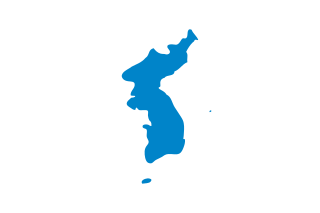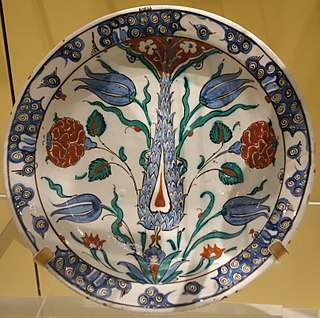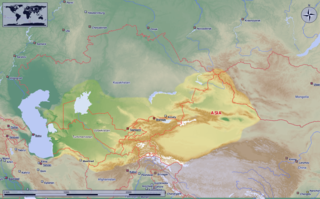Sienna is an earth pigment containing iron oxide and manganese oxide. In its natural state, it is yellow-brown and is called raw sienna. When heated, it becomes a reddish brown and is called burnt sienna. It takes its name from the city-state of Siena, where it was produced during the Renaissance. Along with ochre and umber, it was one of the first pigments to be used by humans, and is found in many cave paintings. Since the Renaissance, it has been one of the brown pigments most widely used by artists.
Prussian blue is a dark blue pigment produced by oxidation of ferrous ferrocyanide salts. It has the idealized chemical formula Fe
7(CN)
18. Another name for the color is Berlin blue or, in painting, Parisian or Paris blue. Turnbull's blue is the same substance, but is made from different reagents, and its slightly different color stems from different impurities.

Umber is a natural brown or reddish-brown earth pigment that contains iron oxide and manganese oxide. Umber is darker than the other similar earth pigments, ochre and sienna.
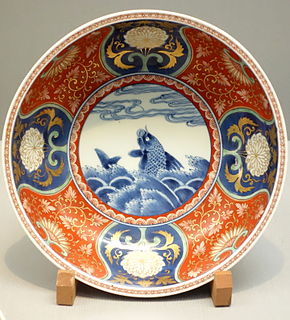
Imari ware is a Western term for a brightly-coloured style of Arita ware Japanese export porcelain made in the area of Arita, in the former Hizen Province, northwestern Kyūshū. They were exported to Europe in large quantities, especially between the second half of the 17th century and the first half of the 18th century.

A National Treasure is a tangible treasure, artifact, site, or building which is recognized by the South Korean government as having exceptional artistic, cultural and historical value to the country. The title is one of the eight State-designated heritage classifications assigned by the administrator of the Cultural Heritage Administration (CHA) in accordance with the Cultural Heritage Protection Act after deliberation by the Cultual Heritage Committee.

Korean ceramic history begins with the oldest earthenware dating to around 8000 BC. Influenced by Chinese ceramics, Korean pottery developed a distinct style of its own, with its own shapes, such as the moon jar or maebyeong version of the Chinese meiping vase, and later styles of painted decoration. Korean ceramic trends had an influence on Japanese pottery and porcelain. Examples of classic Korean wares are the celadons of the Goryeo dynasty (918–1392) and the white porcelains of the Joseon dynasty (1392–1897).

"Blue and white pottery" covers a wide range of white pottery and porcelain decorated under the glaze with a blue pigment, generally cobalt oxide. The decoration is commonly applied by hand, originally by brush painting, but nowadays by stencilling or by transfer-printing, though other methods of application have also been used. The cobalt pigment is one of the very few that can withstand the highest firing temperatures that are required, in particular for porcelain, which partly accounts for its long-lasting popularity. Historically, many other colours required overglaze decoration and then a second firing at a lower temperature to fix that.

Cobalt glass—known as "smalt" when ground as a pigment—is a deep blue colored glass prepared by including a cobalt compound, typically cobalt oxide or cobalt carbonate, in a glass melt. Cobalt is a very intense glass colorant and very little is required to show a noticeable amount of color. Cobalt blue glass is also used as an optical filter in flame tests to filter out the yellow flame caused by contamination with sodium, and expand the ability to see violet and blue hues.

Swatow ware or Zhangzhou ware is a loose grouping of mainly late Ming dynasty Chinese export porcelain wares initially intended for the Southeast Asian market. The traditional name in the West arose because Swatow, or present-day Shantou, was the South Chinese port in Guangdong province from which the wares were thought to have been shipped. The many kilns were probably located all over the coastal region, but mostly near Zhangzhou, Pinghe County, Fujian, where several were excavated in the mid-1990s, which has clarified matters considerably.

Transfer printing is a method of decorating pottery or other materials using an engraved copper or steel plate from which a monochrome print on paper is taken which is then transferred by pressing onto the ceramic piece. Pottery decorated using the technique is known as transferware or transfer ware.

Chinese ceramics show a continuous development since pre-dynastic times and are one of the most significant forms of Chinese art and ceramics globally. The first pottery was made during the Palaeolithic era. Chinese ceramics range from construction materials such as bricks and tiles, to hand-built pottery vessels fired in bonfires or kilns, to the sophisticated Chinese porcelain wares made for the imperial court and for export. Porcelain was a Chinese invention and is so identified with China that it is still called "china" in everyday English usage.

Overglaze decoration, overglaze enamelling or on-glaze decoration is a method of decorating pottery, most often porcelain, where the coloured decoration is applied on top of the already fired and glazed surface, and then fixed in a second firing at a relatively low temperature. It is often described as producing "enamelled" decoration. The colours fuse on to the glaze, so the decoration becomes durable. This decorative firing is usually done at a lower temperature which allows for a more varied and vidid palette of colours, using pigments which will not colour correctly at the high temperature necessary to fire the porcelain body. Historically, a relatively narrow range of colours could be achieved with underglaze decoration, where the coloured pattern is applied before glazing, notably the cobalt blue of blue and white porcelain.

Manwoldae Palace was the official royal palace of the Goryeo Dynasty. Located in the ancient capital city of Kaesŏng, the palace was completely destroyed during the Red Turbans invasions of Korea during the 14th century.

Jingdezhen porcelain is Chinese porcelain produced in or near Jingdezhen in southern China. Jingdezhen may have produced pottery as early as the sixth century CE, though it is named after the reign name of Emperor Zhenzong, in whose reign it became a major kiln site, around 1004. By the 14th century it had become the largest centre of production of Chinese porcelain, which it has remained, increasing its dominance in subsequent centuries. From the Ming period onwards, official kilns in Jingdezhen were controlled by the emperor, making imperial porcelain in large quantity for the court and the emperor to give as gifts.
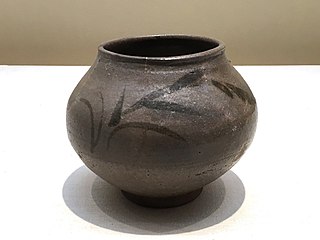
Karatsu ware is a style of Japanese pottery produced traditionally in and around Karatsu, Saga Prefecture.

Goryeo ware refers to all types of Korean pottery and porcelains produced during the Goryeo dynasty. Goryeo ware most often however refers to celadon (greenware). The Gangjin Kiln Sites produced a large number of wares.

This covered jar with a carp design is a piece of porcelain from the Jiajing period of the Ming Dynasty in China, currently located in the Indianapolis Museum of Art, which is in Indianapolis, Indiana. Created between 1522 and 1566, it is exceptionally large and elaborate and would have been a source of great prestige for its owner.
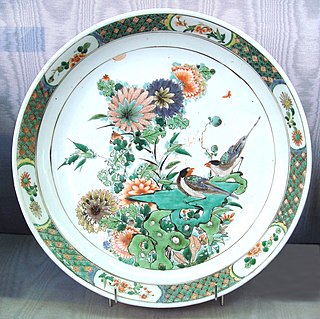
China painting, or porcelain painting, is the decoration of glazed porcelain objects such as plates, bowls, vases or statues. The body of the object may be hard-paste porcelain, developed in China in the 7th or 8th century, or soft-paste porcelain, developed in 18th-century Europe. The broader term ceramic painting includes painted decoration on lead-glazed earthenware such as creamware or tin-glazed pottery such as maiolica or faience.

Hirado ware is a type of Japanese porcelain mostly made at kilns at Mikawachi, Sasebo, Nagasaki, and it is therefore also known as Mikawachi ware. It was made in the former feudal Hirado Domain, which owned the kilns, and was responsible for establishing and directing their production.


